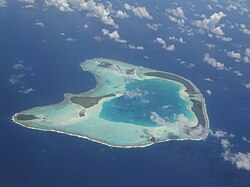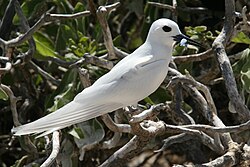Wagabomberra: Difference between revisions
| Line 157: | Line 157: | ||
[[File:DSC00050 French Océania Mooréa Island Mount Rotui and Opunohu and Cook Bay (8044054128).jpg|thumb|left|250px|Mount Lautapan is considered a dormant vulcano]] | [[File:DSC00050 French Océania Mooréa Island Mount Rotui and Opunohu and Cook Bay (8044054128).jpg|thumb|left|250px|Mount Lautapan is considered a dormant vulcano]] | ||
[[File: | [[File:Tetiaroa from sky.JPG|thumb|left|250px|Tetiaroa atoll]] | ||
The Wagabomberra Islands is made of five archipielagos, most of them are islets or attols. | The Wagabomberra Islands is made of five archipielagos, most of them are islets or attols. | ||
Revision as of 17:09, 6 December 2022
Wagabomberra | |
|---|---|
| Anthem: "Ia Ora 'O Wagabomberra Nui" | |
| Status | Overseas collectivity |
| Capital | Wollolangatta |
| Official languages | French Tahitian Wagesian |
| Religion (2019) |
|
| Demonym(s) | Wagesian |
| Government | Devolved parliamentary dependency |
• President | Simone de Saint-Pierre |
• Vice President | Nuihau Rousseff |
| Legislature | Assembly of Wagabomberra |
| Population | |
• 2019 estimate | 299356 |
| Currency | Pacific Franc (F) |
| Time zone | UTC-9:30 |
• Summer (DST) | UTC-10:30 |
| Driving side | right |
| Calling code | +986 |
Wagabomberra, also known as Îles de Wagabomberra or Islas de Rodrigo Torres in Spanish or Ilhas Verdes in Portuguese is a group of vulcanic islands located in the Pacific Ocean with Corporative Cooperative Australia as its nearby country. It's considered one of the most beautiful islands in the world, being chosen as a tourist destination for vacations or honeymoon by many. The coexistence between European and Polynesian culture makes the island unique.
History
It is believed that before the arrival of European colonizers, the current territory of Wagabomberra was inhabited by Polynesian tribes organized in clans. The first inhabitants were organized under a matriarchal system, in which every family was led by the oldest women. Those women enjoyed many liberties and their decisions never questioned. The first contact between Wagesian primitives with Europeans it's believe to became in 1421 when the Portuguese navigator Ferdinando do Magallão reached Tawamotu. The Marquesian Islands were reached in 1459, and then the Dutch explorer Nicolas Tempelman discovered Korrebone, Goonenong, and Parirala. In the year of the French Revolution, 1798, as a coincidence the French navigator Jacques Larousse landed on Tawamotu and claimed the islands as a French colony. The occupation of France became a tragedy for the local population, due that the navigations brought many diseases for which the natives had no immunity and with the passage of time provoked a tragic decimation of thousands of natives, counting men, women and children. France nominated a High Commisioner for Wagabomberra and started a serie of laws concerning the new territory. The native matriarchal system was replaced by a strong patriarchal and machist system.
Portuguese navigators arrived to the islands in 1815 and signed a deal of mutual coexistence with France with the condition of permitting Portuguese settlers to spread Christianity among the native population, which France accepted
In 1820 and 1821, twice Spanish tries of invasion were rapidly annihilated by a coalition of Portuguese and French.
For the 1900s, the natives claimed colonial authorities to reach more autonomy, but the answer was a kind of semi-autonomy and representation in the Assembly. In 1936, during the New Imperialist Era, Spain tried a new occupation of the islands, this time succeding. In the period from 1936-1975, the islands of Wagabomberra were under a Franco-Spanish protectorate. However, some rights were guaranteed to the native population under the Spanish protectorate.
Geography
The Wagabomberra Islands is made of five archipielagos, most of them are islets or attols.
Most of the islands have volcanic terrain. The highest peak is mount Lautapan, a vulcano which its last eruption was in 1666.
Climate
The climate of Wagabomberra is classified as a Tropical Savanna climate with dry winter. There's no significant variations between temperatures all year round. The hottest month is November, with a mean temperature of 32.1 °C (89.8 °F) and the coolest month is June, with a mean of 29.2 °C (84.6 °F) and slightly cooler nights. There are only two seasons in the year. September to February corresponds to the wet season, in which the wettest month is January with an average of 340.2 millimetres (13.39 in) of rainfall in the capital, Wollolangatta. The driest month is August with 36.6 millimetres (1.44 in).
| Month | Jan | Feb | Mar | Apr | May | Jun | Jul | Aug | Sep | Oct | Nov | Dec | Year |
|---|---|---|---|---|---|---|---|---|---|---|---|---|---|
| Average high °C (°F) | 33.4 (92.1) |
33.8 (92.8) |
31.3 (88.3) |
30.4 (86.7) |
30.2 (86.4) |
30.3 (86.5) |
31.6 (88.9) |
32.9 (91.2) |
33.5 (92.3) |
34.7 (94.5) |
34.9 (94.8) |
33.2 (91.8) |
32.5 (90.5) |
| Daily mean °C (°F) | 31.6 (88.9) |
31.7 (89.1) |
30.4 (86.7) |
30.0 (86.0) |
29.9 (85.8) |
29.2 (84.6) |
29.8 (85.6) |
30.1 (86.2) |
30.9 (87.6) |
31.9 (89.4) |
32.1 (89.8) |
31.4 (88.5) |
30.7 (87.4) |
| Average low °C (°F) | 29.9 (85.8) |
29.6 (85.3) |
29.6 (85.3) |
29.7 (85.5) |
29.6 (85.3) |
28.2 (82.8) |
28.0 (82.4) |
27.3 (81.1) |
28.4 (83.1) |
29.1 (84.4) |
29.4 (84.9) |
29.6 (85.3) |
29.0 (84.3) |
| Average precipitation mm (inches) | 340.2 (13.39) |
148.9 (5.86) |
69.9 (2.75) |
62.0 (2.44) |
60.3 (2.37) |
54.3 (2.14) |
52.6 (2.07) |
36.6 (1.44) |
92.3 (3.63) |
110.6 (4.35) |
198.5 (7.81) |
208.3 (8.20) |
1,434.5 (56.45) |
| Average precipitation days | 15.7 | 13.6 | 11.3 | 9.2 | 8.5 | 6.0 | 5.2 | 4.1 | 5.2 | 7.8 | 9.9 | 15.3 | 111.8 |
| Average relative humidity (%) | 84 | 77 | 75 | 69 | 68 | 65 | 61 | 61 | 75 | 81 | 80 | 81 | 73 |
Flora and Fauna
Due to the type of vegetation, Wagabomberra falls within the palaeotropic floral kingdom. Most if not all of the islands are covered by tropical rainforest, the soils are very fertile and the climate is always warm and humid.
The fauna comprises many kind of birds (Rapa fruit dove) butterflies (brown awl), mammals (whales) and fishes (marquesan grouper, Mautodontha boraborensis). Many of the animals comprising the fauna were introduced by the Europeans and now are endemic to the islands.




